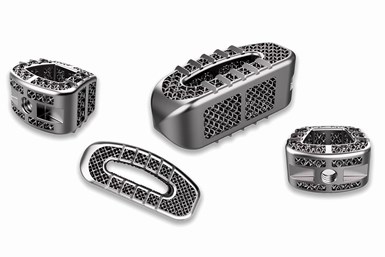NMPA Certifies Farsoon 3D Printed Tantalum Interspinal Fusion Cage
The company says the additively manufactured implants can be fully customized according to patients’ conditions, and the trabecular microstructure can achieve a high porosity of 68-78% to promote bone tissue and vessel fusion.
Tantalum interspinal fusion cage with porous structures designed for 3D printing. Photo Credit: Huaxiang Group
Huaxiang Group, a 3D printing solution provider with expertise in the medical industry, has received the category 3 medical device clearance from China’s National Medical Products Administration (NMPA) for its tantalum fusion cage additively manufactured on a Farsoon metal machine. The company says it is the first NMPA-approved tantalum orthopedic implant built by metal powder bed fusion technology in China.
Known as a specialized metal material with excellent biological inertness and compatibility, stable chemical properties and abrasion resistance, the tantalum metal material is well suited for medical implants. Since its first use in orthopedics in the 1940s, the tantalum has been used in many kinds of medical devices for nearly 80 years.
Due to the extremely high melting point (over 3,000°C), high density (16.6 g/cm3) and elastic modulus (185.7 GPa), the pure tantalum material can be quite challenging to process for use in the medical field. In the past 50 years, the conventional metal tantalum parts were manufactured through a complicated process — powder metallurgy or electron beam melting, deformation, welding and heat treatment.
With the application development of tantalum orthopedic products such as femoral head repair, cranial implant and joint prosthetics, the market has kept pushing the new designs and advanced manufacturing. It is said the tantalum implant with porous structure is proved in clinical practices to reduce stress while providing sufficient mechanical strength. It also encourages bone and vascular tissue growing into the porous structure. The chemical vapor deposition process was then developed for producing commercialized porous tantalum implants for medical use. However, with the limitation of the technology, it is only able to deliver standard end products, with a high manufacturing cost.
Compared to the previous manufacturing processes, Farsoon 3D printed tantalum porous interspinal fusion cage solutions developed by Huaxiang Group offers many advantages from design to manufacturing:
- The additively manufactured implants can be fully customized and produced according to patients’ conditions. The trabecular microstructure can achieve a high porosity of 68-78% to promote bone tissue and vessel fusion.
- The elastic modulus of the 3D printed tantalum implant is highly comparable to human cancellus and trabecular bone. It offers excellent stability, biomechanical compatibility and reduced stress-shielding.
- Precisely produced using the digital model, the implants can achieve high size accuracy, internal structure and designated roughness which only require minimal postprocessing.
- Excellent load-bearing capability. The additively manufactured implant is ready for immediate load-bearing with high toughness, good plasticity and fatigue resistance.
- Sustainable manufacturing with high material utilization.
- Improved efficiency with optimized manufacturing workflow.
- Reduced part lead time and cost.
- Read about Galactic Energy Space Technology’s first successful full-system test flight of its Welkin 50-ton reusable liquid oxygen (LOX)/kerosene engine. Several key components in the rocket engine are 3D printed by aerospace manufacturing service provider Falcontech using a metal laser powder bed fusion solution from Farsoon Technologies.
- Learn more about how Farsoon’s Quad-laser Flight technology on its HT1001P large-format platform offers an enhanced manufacturing speed to maximize production yield and lower manufacturing cost per part.
- Here’s information on how Farsoon’s FS621M Pro-4, FS621M Pro-6 and FS621M-U-4 systems are said to offer huge potential in aerospace applications by lowering operational cost and enabling true industrial-scale series manufacturing.
- This article details how Farsoon’s technology enabled an accelerated design-validation cycle of 80% faster compared to conventional manufacturing processes with the 3D printing of a large combustion chamber.
Related Content
Understanding PEKK and PEEK for 3D Printing: The Cool Parts Show Bonus
Both materials offer properties desirable for medical implants, among other applications. In this bonus episode, hear more from Oxford Performance Materials and Curiteva about how these companies are applying PEKK and PEEK, respectively.
Read More3D Printed Spine Implants Made From PEEK Now in Production
Medical device manufacturer Curiteva is producing two families of spinal implants using a proprietary process for 3D printing porous polyether ether ketone (PEEK).
Read MoreQ&A With Align EVP: Why the Invisalign Manufacturer Acquired Cubicure, and the Future of Personalized Orthodontics
Align Technology produces nearly 1 million unique aligner parts per day. Its acquisition of technology supplier Cubicure in January supports demand for 3D printed tooling and direct printed orthodontic devices at mass scale.
Read MoreMicro Robot Gripper 3D Printed All at Once, No Assembly Required: The Cool Parts Show #59
Fine control over laser powder bed fusion achieves precise spacing between adjoining moving surfaces. The Cool Parts Show looks at micro 3D printing of metal for moving components made in one piece.
Read MoreRead Next
Alquist 3D Looks Toward a Carbon-Sequestering Future with 3D Printed Infrastructure
The Colorado startup aims to reduce the carbon footprint of new buildings, homes and city infrastructure with robotic 3D printing and a specialized geopolymer material.
Read More3D Printed Polymer EOAT Increases Safety of Cobots
Contract manufacturer Anubis 3D applies polymer 3D printing processes to manufacture cobot tooling that is lightweight, smooth and safer for human interaction.
Read MoreProfilometry-Based Indentation Plastometry (PIP) as an Alternative to Standard Tensile Testing
UK-based Plastometrex offers a benchtop testing device utilizing PIP to quickly and easily analyze the yield strength, tensile strength and uniform elongation of samples and even printed parts. The solution is particularly useful for additive manufacturing.
Read More





















